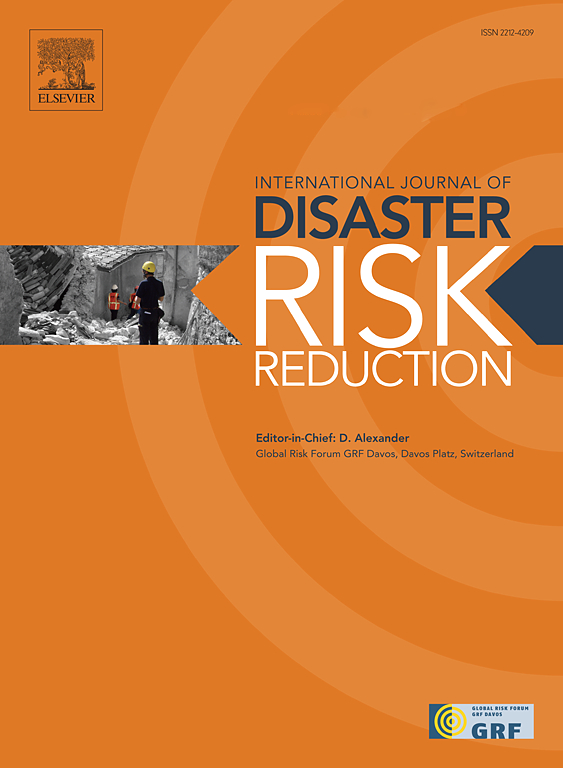超越现场调查:了解三维空间属性在数据驱动的砌体建筑爆炸脆弱性评估中的作用
IF 4.5
1区 地球科学
Q1 GEOSCIENCES, MULTIDISCIPLINARY
International journal of disaster risk reduction
Pub Date : 2025-07-13
DOI:10.1016/j.ijdrr.2025.105672
引用次数: 0
摘要
无加固砌体(URM)建筑极易受到爆炸荷载的影响,然而传统的灾后评估往往无法捕捉到控制结构行为的重要几何和空间属性。本研究利用高分辨率3D数字建模和机器学习(ML)来提取和评估在2020年贝鲁特爆炸中受损的2042座历史URM建筑的空间特征的预测能力。通过将3d衍生属性(包括建筑方向、纵横比和立面开口比)集成到一个有监督的ML框架中,我们实现了超过90%的损伤预测准确率。与以往基于模拟或小规模实验的研究不同——这些研究通常集中在地震荷载上——这项工作提供了一种新颖的、在真实爆炸条件下城市尺度上的几何预测因子的经验分析。该分析表明,虽然屋顶类型和包层等特征(通常在文化遗产文件中优先考虑)的预测价值可以忽略不计,但城市形态和建筑几何形状成为爆炸脆弱性的主要驱动因素。这些发现为计算模拟提供了现实世界的物理驱动指导,强调了在爆炸建模中需要优先考虑3D几何相互作用,而不仅仅是材料特性。对于灾后侦察,研究结果主张重新考虑现场协议,以记录定向、开放分布和城市屏蔽效应,这些属性以前被忽视,但现在被证明可以控制结构弹性。该工作流程从描述性损害清单转变为预测性、数据驱动的脆弱性评估。本文章由计算机程序翻译,如有差异,请以英文原文为准。
Beyond field surveys: Understanding the role of 3D spatial attributes for data-driven blast vulnerability assessment of masonry buildings
Unreinforced masonry (URM) buildings are highly vulnerable to blast loads, yet traditional post-disaster assessments often fail to capture important geometric and spatial attributes that govern structural behavior. This study leverages high-resolution 3D digital modeling and machine learning (ML) to extract and evaluate the predictive power of spatial features across 2042 historic URM buildings damaged in the 2020 Beirut explosion. By integrating 3D-derived attributes, including building orientation, aspect ratio, and façade opening ratio, into a supervised ML framework, we achieved over 90% accuracy in damage prediction. Unlike prior studies based on simulations or small-scale experiments — typically focused on seismic loading — this work offers a novel, empirical analysis of geometric predictors at urban scale under real-world blast conditions. This analysis reveals that while features like roof type and cladding (often prioritized in cultural heritage documentation) show negligible predictive value, urban morphology and building geometry emerge as dominant drivers of blast vulnerability. These findings provide real-world, physics-driven guidance for computational simulations, highlighting the need to prioritize 3D geometric interactions rather than material properties alone in blast modeling. For post-disaster reconnaissance, the results advocate rethinking field protocols to document orientation, opening distribution, and urban shielding effects, attributes previously overlooked but now shown to govern structural resilience. This workflow shifts from descriptive damage inventories to predictive, data-driven vulnerability assessments.
求助全文
通过发布文献求助,成功后即可免费获取论文全文。
去求助
来源期刊

International journal of disaster risk reduction
GEOSCIENCES, MULTIDISCIPLINARYMETEOROLOGY-METEOROLOGY & ATMOSPHERIC SCIENCES
CiteScore
8.70
自引率
18.00%
发文量
688
审稿时长
79 days
期刊介绍:
The International Journal of Disaster Risk Reduction (IJDRR) is the journal for researchers, policymakers and practitioners across diverse disciplines: earth sciences and their implications; environmental sciences; engineering; urban studies; geography; and the social sciences. IJDRR publishes fundamental and applied research, critical reviews, policy papers and case studies with a particular focus on multi-disciplinary research that aims to reduce the impact of natural, technological, social and intentional disasters. IJDRR stimulates exchange of ideas and knowledge transfer on disaster research, mitigation, adaptation, prevention and risk reduction at all geographical scales: local, national and international.
Key topics:-
-multifaceted disaster and cascading disasters
-the development of disaster risk reduction strategies and techniques
-discussion and development of effective warning and educational systems for risk management at all levels
-disasters associated with climate change
-vulnerability analysis and vulnerability trends
-emerging risks
-resilience against disasters.
The journal particularly encourages papers that approach risk from a multi-disciplinary perspective.
 求助内容:
求助内容: 应助结果提醒方式:
应助结果提醒方式:


